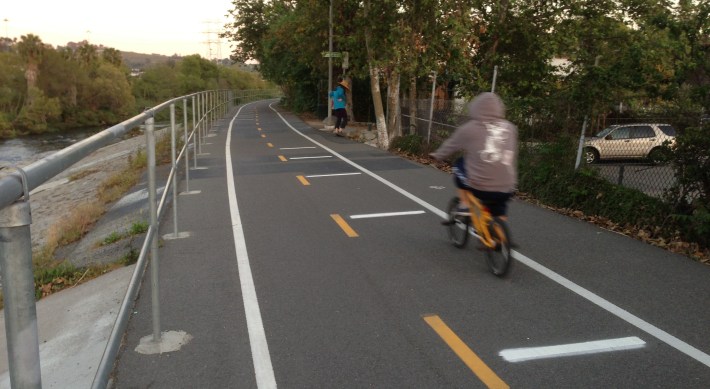
A new report from UCLA's Center for Occupational and Environmental Health sets out to make the connection between bikeways and walking paths along urban rivers and the health costs of physical inactivity in our cities.
The report, Urban River Parkways: An Essential Tool for Public Health [PDF], concludes that building walking and bike paths, parcourses, and other recreational facilities along urban rivers can provide major public health benefits and cost savings to individuals and to society by giving people opportunities to be physically active in relatively enjoyable, stress-free environs.
“I don't think anyone's looked at urban river parkways as a health issue,” said the report's author, Dr. Richard Jackson, UCLA professor and former head of Environmental Health at the Centers for Disease Control. “I have noticed the great frustration of my physician friends, sitting at the end of the disease pipeline. Too many of their patients were suffering complications from obesity, from diabetes—from diseases related to inactivity.”
“We have failed to get people physically active by telling them to join a gym and get on a rowing machine,” he said. “But when we build places that are irresistible, people are active.”
The report compares the costs of building recreational facilities with medical costs resulting from inactivity, and concludes that spending money on facilities more than pays for itself in healthcare cost savings. It concludes that “urban river parkways can be viable, cost-effective health interventions that help direct efforts towards prevention rather than treatment, and increased public utilization increases the benefits with only small increases in the cost of maintenance.”
The report surveys a wide range of studies in public health fields that have quantified the dangers of inactivity—obesity, risk of diabetes and stroke, depression, and anxiety—as well as the benefits of increasing activity—decreased risk of disease, increased life span, better moods, mental health, and physical strength, less stress, and fewer work and school days missed.
Potential environmental benefits of developing recreation along urban rivers, such as better water filtration from permeable surfaces, cleaner air from increased vegetation, and a lessening of the urban heat island effect, are also pointed out.
“We have never looked at this kind of investment as a health investment,” said Jackson. “We need to figure out ways that we can get credit for the benefits of creating physical activity.”
These benefits could come from any kind of facility that gets people moving, not just urban river parkways, but the authors focused on those for a few reasons. Land around rivers is usually relatively level, and in cities it's also usually a publicly owned right of way. They are also potentially long enough to provide real exercise, and to provide opportunities to commute along them rather than drive to work. “Many people would rather bike along the American River Parkway in Sacramento than be stuck in traffic along Highway 80,” he said.
Some of the data mined by the report include these gems:
- By one estimate, for every $1 spent on trails, $2.94 is saved in direct medical benefit.
- One study found that the annual cost per user of building and maintaining urban river trails is between $83 and $592, while the annual public health cost per capita of physical inactivity is $622.
- Obesity accounts for 21 percent of overall healthcare costs in the U.S.
- The creation of one miles of trail is, at the most expensive, less than health costs relating to obesity and diabetes.
- Exercise with views of nature led to more consistent mental health improvements than exercise with no or an unpleasant view.
The report concludes that “urban river parkways can be viable, cost-effective health interventions that help direct efforts towards prevention rather than treatment, and increased public utilization increases the benefits with only small increases in the cost of maintenance.”






